Studi mengenai proyek Hambalang ini dilakukan oleh penulis bekerja sama dengan PT. Wiratman&Associates, atas permintaan Lost Adjuster yang ditunjuk Konsorsium 8 perusahaan asuransi yg mengcover proyek ini. Jadi laporan ini sama sekali tidak terkait dengan KEMENPORA maupun pihak pemerintah lainnya. Pertanyaan yg harus dijawab dari studi ini adalah: 1.Apakah kelongsoran/failure yg terjadi sesuatu yg foreseen atau unforeseen, 2. Apa penyebab kelongsoran/failure.
Penulis bertanggung jawab atas masalah geoteknik, sedangkan PT W&A bertanggung jawab atas geological mapping keseluruhan bukit Hambalang dari puncak bukit sampai sungai dibawah project site, dan pekerjaan pemboran tambahan pada titik2 yang diminta oleh penulis. Laporan ini telah selesai kira2 sebulan yl, dan telah dipresentasikan dimuka perusahaan2 asuransi dan lost adjuster, dan terakhir dimuka kontraktor proyek yang menghire Prof. Paulus Pramono sebagai tenaga ahli untuk mengomentari laporan ini. Laporan ini telah diterima dengan baik oleh semua pihak.
Koreksi wording telah diberikan lost adjuster agar tim teknis tidak terbawa-bawa dalam masalah2 diluar teknis. Keberatan kontraktor adalah pada Point G kesimpulan: …….the information regarding susceptibility of the project site to sliding has been widespread among engineers……….., telah diakomodasi dengan mengganti kata engineers pada final report menjadi geotechnical engineers.
Sekalipun hanya menyajikan kesimpulan dari laporan dan gambar2 terkait yg penulis susun khusus utk tulisan di blog ini, penulis percaya bahwa informasi ini cukup bagi seorang geotechnical engineer untuk dapat mengerti apa yg sesungguhnya terjadi. Terakhir, perlu penulis luruskan pendapat beberapa ahli yg mengatakan bahwa tanah Hambalang expansive adalah tidak benar. Tanah Hambalang ini berbeda dengan tanah expansive sepanjang area Cikarang sampai Cikampek.
6. CONCLUSIONS AND RECOMMENDATIONS
Geological and geotechnical study on the Hambalang project site leads to the following conclusions and recommendations:
A. The project site is naturally susceptible to land sliding. But, it does not mean that the land sliding cannot be anticipated. We understand that it will be costly.
B. Sliding can occur through the young volcanic product as well as through the weathered clay shale. Comparing the two main soil layers, the young volcanic product is more susceptible to land sliding. Oversaturation of unprotected layer of young volcanic product may cause land sliding.
C. Sliding through the young volcanic product will occur in a limited extent, covering relatively small area. On the other hand, sliding through the weathered clay shale will take place in a large extent, covering large area. Sliding through the weathered clay shale will be preceded by several small ground movements, creating cracks on the ground, through which more water will enter the ground, reducing the strength of the soils to critical values. This type of sliding has occurred on the Power House, causing the damage of the building.
D. Considering that the Hambalang project site is susceptible to land sliding, cut and fill should be carefully designed.
E. Softening/weathering of the clay shale may different from place to place. Hence, to get thorough information on soil condition required for construction project, more extensive soil investigation is required, compared to normal project site.
F. To stabilize steep slopes, especially the ones close to the building(s), rigid retaining structures is recommended compared to flexible ones, such as geotextile wall.
G. We believe the information on susceptibility of the project site to land sliding has been widespread among geotechnical engineers, even for the one who never involved in any project in Hambalang surrounding area.
Six (6) boreholes which had been drilled by PT. Wiratman & Associates at five (5) sliding areas clearly indicate the existence of clay shale, which belongs to Jatiluhur Formation. Its characteristics are hard in its natural condition and it will break into gravel size when exposed or when its overburden pressure is reduced. The gravel size clay shale will lose most of its strength once it is exposed to ground water. This condition is likely to occur since the ground water cannot penetrate the fresh clay shale, hence, it will flow through the weathered clay shale.
The slopes at the project site looks like stable, but actually they are in critical condition, as they have only marginal Safety Factors. If the project will be continued adopting the present cut and fill design, it can be predicted that land sliding will occur sometime during rainy season.
Considering that it will be difficult to repair sliding slopes, especially the ones which are steep and located close to the building(s), anticipation to land sliding should be carried out from the beginning of the project, at least before starting construction works. Thorough review on cut and fill design should be conducted before construction.
H. Even the design calculation of the building foundation was not available, field observation indicates that it is most probably the building foundations were conservatively designed. It is the fact that the GOR pile foundation is still stable supporting the building load, even several meters of the top part of the piles are exposed as the result of geotextile wall failure. Another fact is that there is no other building failure except the Power House, even though small land sliding and geotextile wall failure occurred at some places. The last, the Geoinvest Report recommend the use of pile lengths in such that the piles at least socketted 5 m in fresh clayshale. It is most probably that the designer adopt the recommendation.
The above clearly indicates that the building foundations were conservatively designed; only large sliding through weathered clayshale may damage the piles, resulting in building collapse.
– End of Report –
Fig.1: Locations of Sliding/Failure
Fig.2: General Soil Stratigraphy
Fig.3: Comparison of two boreholes, which looks different due to the existence of gravel size clay shale at BH-2. Someday the boreholes will be the same.
Fig 4: Land Sliding at Power House Causing the Damage of the Building
Fig 5: Geotextile Wall Failure at Asrama Elit Putri
Fig 6: Geotextile Wall Failure at GOR
Fig.7 : Geotextile Wall Failure at Asrama Elit Putra


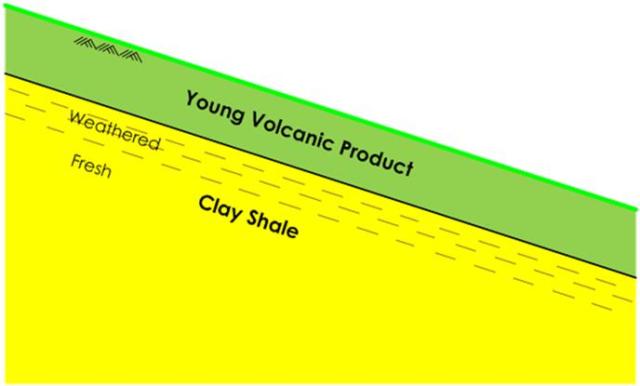
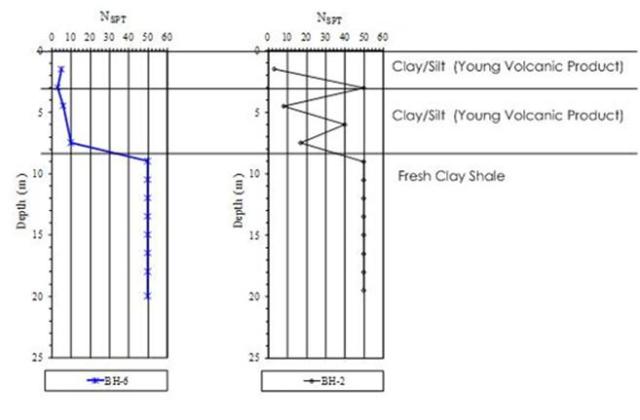
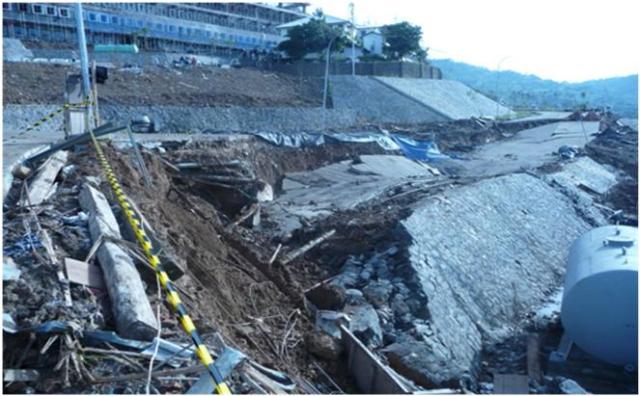
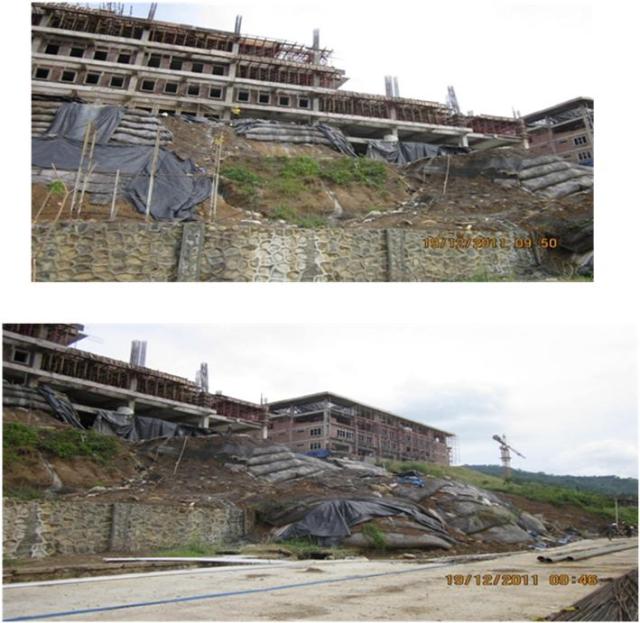
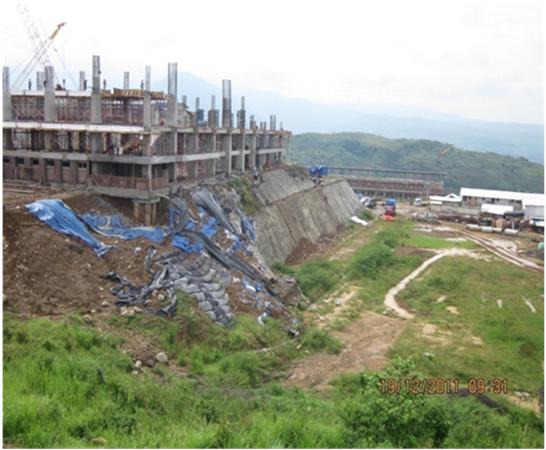
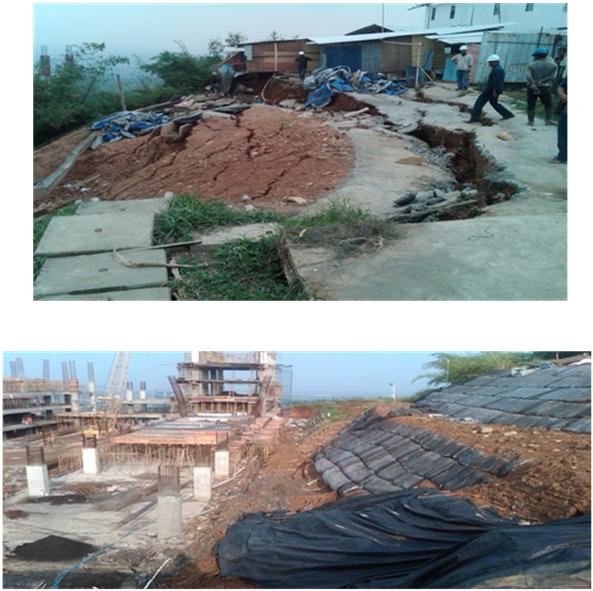
GreatJob and WellDone…Bravo pak….
Thanks Pak Annin.
sejauh yg saya tahu, clay shale itu expansif, memang jika belum ter-expose biasanya keras, tapi begitu expose akibat digali dia akan hancur jadi tanah dan umumnya mempunyai muneral lempung monthmorilonite.